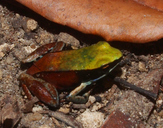|
Description
M 22-25 mm, W 27-30 mm. Head, dorsum and largest (posterior) part of the flanks usually light green to yellowish. Upper surface of legs with similar colour and without dark crossbands. Anterior part of the flanks black. Distinct, white to light green frenal stripe until snout tip. Upper half of the iris golden. Ventrally black with bluish white markings. Distinct horseshoe marking on the throat.
Similar species: Typically coloured specimens are easily recognizable, but more ebenaui-like coloured specimens occur as well.
Distribution and Habitat
Country distribution from AmphibiaWeb's database: Madagascar
Antongonbato, Montagne des Français. It is observed from sea level to 959m asl in deciduous dry forest on karst landscape. It can live in degraded habitats but requires shade and good vegetation cover (Andreone et al. 2008).
Life History, Abundance, Activity, and Special Behaviors
Habits: Adult specimens were found along (nearly dry) brooks in the forest. Some weak calling activity was recognizable in March.
In captivity aggressive behaviour was observed in females and inguinal clasping has been recorded.
Call: The call consists of a series of very short notes. Each note consists of two very short clicks, with a very short interval between them. Duration of the first click is about 10 ms, duration of the second about 20 ms. The second click is more intense. Duration of the whole double-click note is about 40 ms. Frequency ranges from 2.5-6.2 kHz.
Eggs and tadpoles (from Montagne des Francais): The tadpoles, which were found in a small pool of a dry brook, are similar to other Mantella tadpoles. Total length in stage 25 is 15-18 mm, body length 5-6 mm. Eyes are directed dorsally. Tooth formula is 1/4+4//3.
Breeding takes place near temporary brooks and streams (Andreone et al. 2008).
Trends and Threats
Endangered: extent of occurrence is less than 5,000 km2, its distribution is severely fragmented, and there is continuing decline in the extent and quality of its habitat. It does not occur in any protected areas (though it has been recorded from a classified forest), and increased protection and maintenance of the remaining habitat is needed. Any future trade in this species should be carefully regulated. It is maintained in captivity in several facilities outside Madagascar (Andreone et al. 2008) Comments
Taken with permission from Glaw and Vences (2007).
References
Andreone, F., Raxworthy, C., and Vences, M. (2008). Mantella viridis. In: IUCN 2008. 2008 IUCN Red List of Threatened Species. www.iucnredlist.org. Downloaded on 21 April 2009.
Glaw, F., and Vences, M. (2007). Field Guide to the Amphibians and Reptiles of Madagascar. Third Edition. Vences and Glaw Verlag, Köln.
Originally submitted by: Miguel Vences and Frank Glaw (first posted 2000-12-13)
Edited by: Henry Zhu (2009-05-06)Species Account Citation: AmphibiaWeb 2009 Mantella viridis <https://amphibiaweb.org/species/4569> University of California, Berkeley, CA, USA. Accessed May 30, 2025.
Feedback or comments about this page.
Citation: AmphibiaWeb. 2025. <https://amphibiaweb.org> University of California, Berkeley, CA, USA. Accessed 30 May 2025.
AmphibiaWeb's policy on data use.
| 